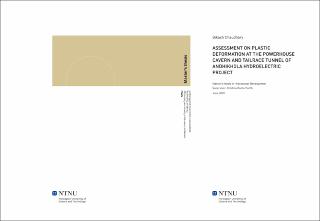| dc.description.abstract | There are several risks and challenges associated with underground excavation especially in case of weak and schistose rock mass. One of the major instability issues is the high induced stress around the excavation boundary. Once the magnitude of these induced stresses exceeds the rock mass strength, the yielding of rock mass occurs resulting in displacement around the excavation contour. Tunnels and caverns excavated in weak and deformable rock mass under high rock cover are more likely to experience instability in the form of deformation. In many cases, those deformation is of significant magnitude and is irreversible, which is often called as plastic deformation also known as tunnel squeezing in case of weak rock. Squeezing phenomena in underground excavation are very common in weak rocks such as shale, slate, phyllite and schist of the lesser Himalayan and Siwaliks zones, and in weakness/fault zones (Panthi, 2006).
In this thesis, Andhikhola Hydropower Project (AKHP), located in lesser Himalayan of Nepal has been taken as case study. This hydropower project experienced substantial plastic deformation (squeezing phenomena) in some stretches of tailrace tunnel and minor squeezing in powerhouse cavern which were initially in complete stable condition for last 3 decades. The squeezing phenomena was noticed only after upgrading the project to higher capacity which demanded the existing tailrace tunnel and cavern to be enlarged in cross section. The major squeezing occurred in tailrace tunnel in which the most critical section was from chainage 0+390 to 0+410. The convergence measurement of those squeezed tailrace sections was carried out which showed maximum plastic deformation of 14.5cm. Powerhouse cavern experienced 50-100mm of plastic deformation on walls just after the longitudinal extension. The rock types along the powerhouse cavern and tailrace tunnel are fresh to moderately weathered slate intercalated with phyllite.
The main focus of this thesis is the documentation and assessment of plastic deformation of the powerhouse cavern and tailrace tunnel of AKHP. The objective involves an evaluation of available methods for prediction and assessment of squeezing of underground excavation. For this study, the methods that have been used to analyze the plastic deformation are: empirical methods such as Singh et al. (1992) and Q-system (Grimstad and Barton, 1993), semi-analytical method Hoek and Marinos (2000), and numerical modeling in RS2 and RS3. Calibration of the major input parameters like stress conditions and rock mass deformability has been carried out using the numerical analysis. As per the squeezing prediction criteria such as Singh et al. (1992), Q-system and Hoek and Marinos (2000), there is severe squeezing problem in the selected tailrace sections and minor squeezing in the powerhouse cavern. Hoek and Marinos (2000) show there is substantial amount of plastic deformation in tailrace tunnel. The numerical analysis was carried out for the tailrace tunnel section (chainage 0+400) which experienced the maximum deformation whereas for powerhouse cavern, the existing powerhouse cavern was modeled both in 2D and 3D so investigate the effect of extension.
The accuracy of the plastic deformation analysis largely depends on the correct estimation of input parameters mainly: induced rock stress and rock mass deformability parameters. The induced stress over the excavation opening are the resultant of stress due to gravity and tectonic stresses. Since there were not any rock stress measurement carried out at the site, the RS2 program has been used to calibrate these values using the measured deformation. However, stress measurement will be necessary to verify this value. Also, the Uniaxial unconfined strength of intact rock of the tunnel sections has been back calculated from measured deformations using RS2 program and found to be in the range of 10 Mpa for tailrace sections and 30Mpa for powerhouse cavern. The analysis from all the above-mentioned methods indicates that that there is significant plastic deformation in the selected sections of tailrace tunnel and minor deformation in cavern. | en_US |
